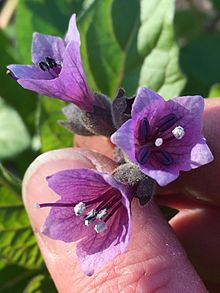| Physochlaina | |
|---|---|

| |
| Physochlaina orientalis | |
| Scientific classification | |
| Kingdom: | Plantae |
| Clade: | Tracheophytes |
| Clade: | Angiosperms |
| Clade: | Eudicots |
| Clade: | Asterids |
| Order: | Solanales |
| Family: | Solanaceae |
| Subfamily: | Solanoideae |
| Tribe: | Hyoscyameae |
| Genus: | Physochlaina G.Don |
| Species | |
|
6–10, see text | |
Physochlaina is a small genus of herbaceous perennial flowering plants belonging to the nightshade family, Solanaceae,[1] found principally in the north-western provinces of China (and regions adjoining these in the Himalaya and Central Asia)[2][3] although one species occurs in Western Asia, while others occur in Siberia, Mongolia and the Chinese autonomous region of Inner Mongolia. Some sources[4] maintain that the widespread species P. physaloides is found also in Japan, but the species is not recorded as being native in one of the few English-language floras of the country.[5] The genus has medicinal value, being rich in tropane alkaloids, and is also of ornamental value, three species having been grown for ornament, although hitherto infrequently outside botanical gardens. Furthermore, the genus contains a species (P. physaloides – recorded in older literature under the synonyms Hyoscyamus physalodes, Hyoscyamus physaloides and Scopolia physaloides) formerly used as an entheogen in Siberia (re. which see translation of Gmelin's account of such use below).[6]
- ^ Armando T. Hunziker: The Genera of Solanaceae. A.R.G. Gantner Verlag K.G., Ruggell, Liechtenstein 2001. ISBN 3-904144-77-4.
- ^ An-ming, Lu and Zhi-yu, Zhang Studies of the Subtribe Hyoscyaminae in China, paper no. 5 in Solanaceae : Biology and Systematics, Ed. William G. D'Arcy, pub. Columbia University Press 1986.
- ^ Polunin, Oleg and Stainton, Adam, Flowers of the Himalaya, pub. Oxford University Press 1984, pps. 288-9.
- ^ https://cicon.ru/physochlaina-physaloides.html Retrieved 11.28 a.m. on Tues 7/4/20
- ^ Ohwi, Jisaburo, National Science Museum, Tokyo, Japan, Flora of Japan (in English) pub. Smithsonian Institution Washington DC 1965. p. 787: Fam. 176 Solanaceae https://ia802308.us.archive.org/BookReader/BookReaderImages.php?zip=/31/items/floraofjapaninen00oiji/floraofjapaninen00oiji_jp2.zip&file=floraofjapaninen00oiji_jp2/floraofjapaninen00oiji_0007.jp2&scale=4&rotate=0 Retrieved 11.37 a.m. on Tue 7/4/20
- ^ Rätsch, Christian, The Encyclopedia of Psychoactive Plants: Ethnopharmacology and Its Applications pub. Park Street Press 2005